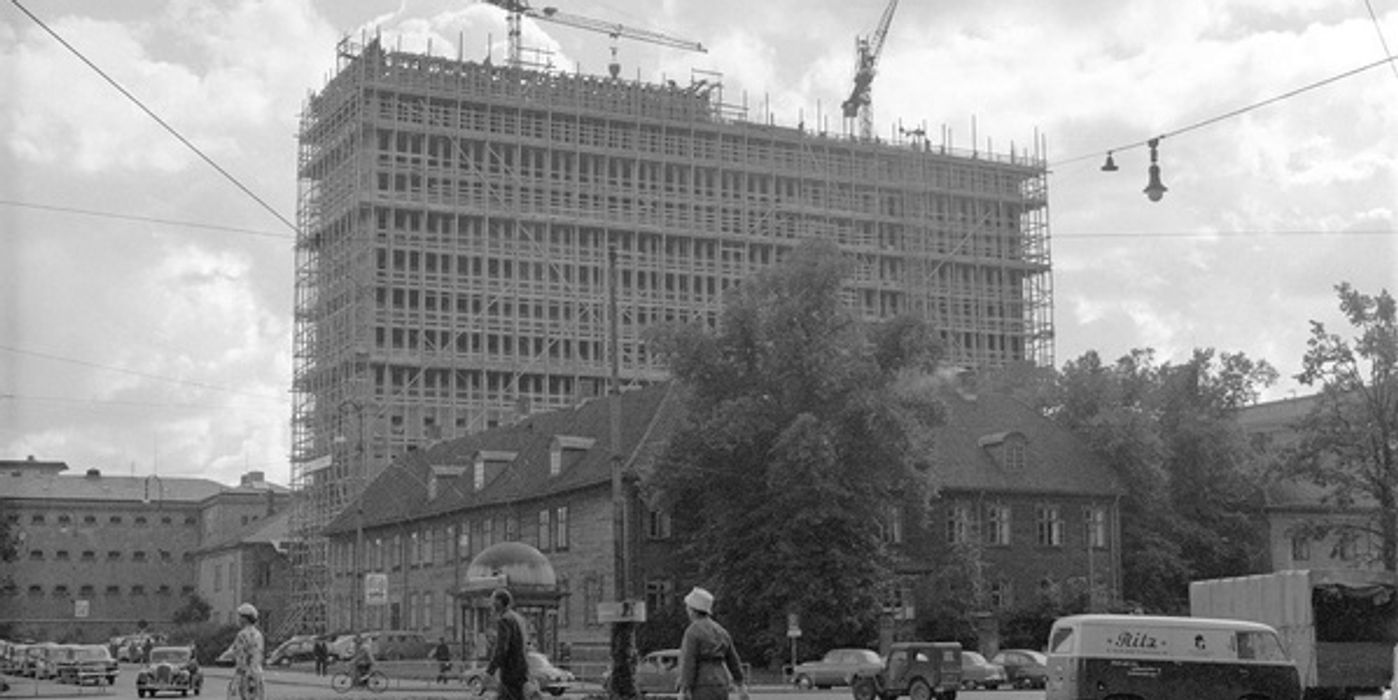Related topics
By: Christina Marwold, 22 July Centre
Published: June 2020
Edited: January 2023

By: Christina Marwold, 22 July Centre
Published: June 2020
Edited: January 2023
In 1883, the Ministry of Justice moved into the main building of the old hospital. The government then took over the old hospital buildings one after the other. None of these buildings was designed for departmental work, and calls were made for buildings that were adapted to the government apparatus.
The G Building (G-blokka) became the first building in the government building complex. It was designed by Henrik Bull and was completed in 1906. Due to a strained financial situation, only the side wing was completed. On 22 July 2001, the building housed the Ministry of Finance. The explosion damaged the building, but its use was quickly resumed after the completion of the removal work.
The high-rise building (Høyblokka) was completed in 1958 and was designed by the architect Erling Viksjø. It was designed to reflect the social democratic values of openness and community. From 1958 until the terror attack in 2011, all the Norwegian prime ministers have had their office in the top floor of the high-rise building. The Ministry of Justice and the Police occupied the other floors.
The government building complex was meant to be open to the public, and the art that decorated it available to everyone. In the 1960s, traffic went under the high-rise building, through what later became the reception. Although the passage was eventually glassed-in, openness was still encouraged by letting the city’s inhabitants pass through the reception.The high-rise building was the target of the first attack on 22 July 2011. The building was completely destroyed in the explosion.
The Y Building (Y-blokka) was completed in 1969. The most famous elements of the building are Pablo Picasso's artistic contributions, with three unique motifs: The Beach, The Seagull and The Fishermen, and a motif based on earlier works; Satyr, Faun and Centaur. When the bomb went off on 22 July 2011, the building housed the Ministry of Education and Research. The building sustained extensive damage.
The S Building (S-blokka) and the R4 building were designed by Viksjø’s architectural company in 1978 and 1988, respectively. Together with the Y Building and the high-rise building, they made up Einar Gerhardsens Plass square.
When the bomb exploded on 22 July 2011, the Ministry of Health and Care Services and the Ministry of Labour were housed in the S Building, while the Ministry of Petroleum and Energy, the Ministry of Industry and Trade and the Government Administration Services were housed in R4. Both buildings sustained extensive damage in the terror attack. The S Building and R4 were demolished in 2014/2015 and 2019, respectively.
It has been stated as an expressed goal that the new government building complex that is under construction should reflect the objectives that permeated the public debate, and not least Prime Minister Jens Stoltenberg’s speeches in the days following the terror attack; that the terrorist’s anti-democratic actions must be met with more democracy, more openness, but never naivety.
New layers will be added to the memory landscape in the new government building complex. One layer will exist next to the new and forward-looking structures: Remnants after the terror attack in 2011 will be preserved and will make its mark on the building complex, as a reminder to coming generations about what was under attack that Friday and what must be protected in the future. This will remind us of those we lost and why we must never take democracy for granted.
References:
Eriksen, T. et al. (2006) Den gamle regjeringsbygningen 100 år – et byggverk og et embetsverk. Finansdepartementet. https://www.regjeringen.no/contentassets/637e61c45fc34b79abadde577a985e29/r-0606_jubileumsbok.pdf
Jenssen, H. L. (2013) Høyblokken: en bygningsbiografi. Forlaget Press
Kommunal- og moderniseringsdepartementet (2019) Kunst, arkitektur og bygninger i regjeringskvartalet. https://www.regjeringen.no/no/tema/plan-bygg-og-eiendom/regjeringskvartalet/bygninger/id712727/
Regjeringen (2013) Dagens tilstand: Historisk utvikling. https://www.regjeringen.no/globalassets/upload/fad/vedlegg/bst/dagens_tilstand_historisk_utvikling.pdf
Regjeringen (2014) 1958: Statsministeren flytter til Høyblokken. https://www.regjeringen.no/no/dep/smk/ansvarsomrader/forloperne/1946--nyere-tid/1958-Statsministeren-flytter-til-Hoyblokken/id759096/
Riksantikvaren (2013) Regjeringskvartalet. Riksantikvarens utredning om verneverdi og ny bruk. https://core.ac.uk/download/pdf/52075348.pdf